这篇文章主要讲解了“如何快速模拟出后端接口”,文中的讲解内容简单清晰,易于学习与理解,下面请大家跟着小编的思路慢慢深入,一起来研究和学习“如何快速模拟出后端接口”吧!
我做前端或者客户端开发,对我有什么用?
在后端 API 开发缓慢的时候,如果你想测试应用展示效果,就不必再等后端进度,使用 moco 轻松模拟后端 API。
在项目初期的时候,产品经理或者是客户想看到你的应用展示,模拟好 API 就可以开发前端,展示效果啦。
我做后端开发,对我有什么用?
企业级软件一般都是多人开发,因为接口之间是互相依赖的,所以如果你依赖的服务进度缓慢或者是没有在环境中运行,你就无法对你开发的功能进行测试,进而不能及时交付项目,从而加班熬夜。
即使你所依赖的服务在环境中运行,但是所依赖的服务依旧会不断测试和调优,这个过程也可能会导致你开发功能测试出现问题。一个稳定的测试接口,减少你的等待时间。
JDK 1.8+ (推荐1.8版本)点击此处下载 jar 包
新建 hello.json 文件,写入以下内容
[{ "description": "moco 快速开始示例", "request": { "uri": "/hello" }, "response": { "text": "Hello GitHub" } }]目录结构如下
├── hello.json // API 接口配置文件 ├── moco-runner-1.1.0-standalone.jar // 下载的模拟 API 的工具在该目录下运行
java -jar moco-runner-1.1.0-standalone.jar http -p 9999 -c hello.jsonmoco-runner-1.1.0-standalone.jar:运行程序的路径(刚刚下载的包的路径)
http:选择服务类型(有 http、https、socket)
-p 9999:设置服务端口 9999
-c hello.json:设置配置文件路径(刚刚新建的配置文件)
在浏览器中访问一下地址
localhost:9999/hello
效果如图所示

刚刚的你应该十分轻松地模拟一个简单的后端 API,是不是很有成就感?但是你使用或者开发过后端 API 你就也许知道:一个合格的后端 API 不应该仅仅局限如此。一个合格的后端 API 应该能包括:请求方法、请求 URL、请求参数、请求头、请求体、返回状态码、返回提示信息、返回头和返回体等内容。
如何使用 moco 这个开源项目模拟出一个合格的后端接口呢?接下来就带你一步步了解详细用法。
[ { "description": "moco 基本结构", "request": { "uri": "/hello", "method": "post" }, "response": { "text": "Hello GitHub" } } ]json 文件的最层是一个 [] 数组,里面可以封装多个 API(示例只有一个 API)
因为 json 配置文件不支持注释,所以这个 API 的注释你可以写到 description 里面
request 可以包含请求的所有内容
response 可以包含返回的所有内容
[{ "description": "模拟一个基本的 RESTful API", "request": { "uri": "/hello2", "method": "post", "headers": { "Content-Type": "application/json", "Accept": "application/json", "token": "header.playload.signature", "Accept-Charset": "utf8" }, "cookies": { "login": "true" }, "json": { "name": "zhangsan", "age": 13 } }, "response": { "json": { "message": "测试成功" }, "latency": { "duration": 2, "unit": "second" }, "headers": { "Content-Type": "application/json", "token": "new-header.new-playload.new-signature" }, "cookies": { "login": { "value": "true", "domain": "localhost", "secure": "true", "httpOnly": "true", "path": "/" } } } }]method :请求方法
headers :请求头
cookies :请求 Cookies
json :请求体的一种类型(还有 froms 表单等类型)
response headers json cookies
latency 模拟服务器卡顿(因为模拟的后端 API 返回数据几乎是瞬间的,这里我们让其卡顿 2 秒)
这里我们使用 GitHub 上面开源免费的 API 测试软件 Postman 进行测试
(1)url、请求方法、请求头和 Cookies
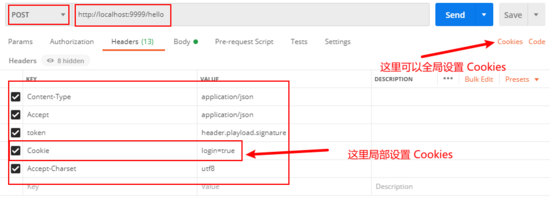
(2)请求体(json)
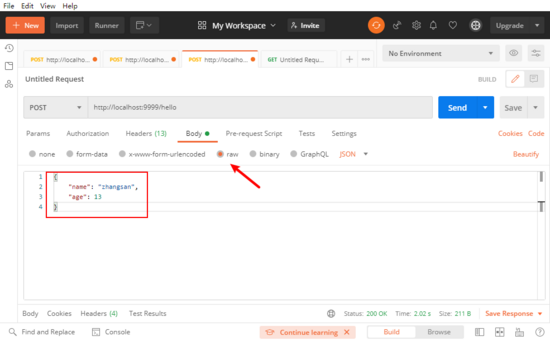
(3)测试效果
点击 Send 发送,并在下方 response 查看测试效果
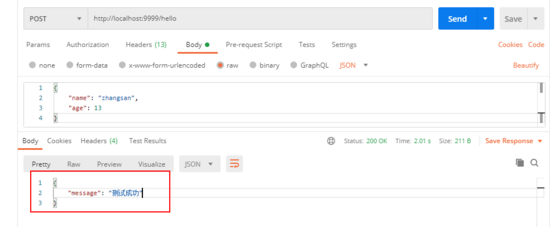
查看返回的请求头
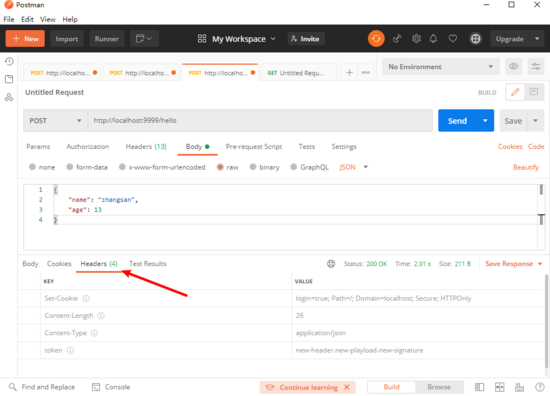
查看返回的 Cookies
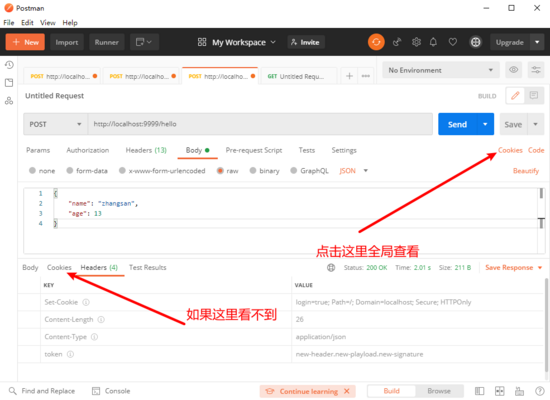
查看全局 Cookies
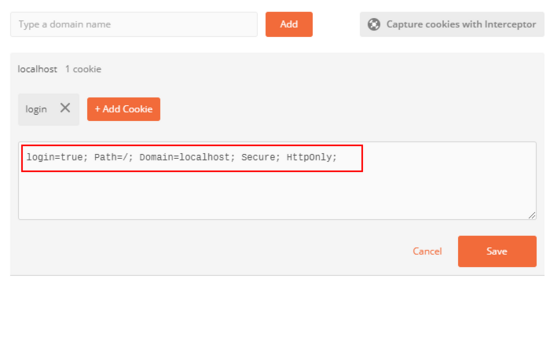
有时候我们需要模拟文件下载,moco 如何实现呢?
[{ "description": "moco 附件下载", "request": { "uri": "/hello" }, "response": { "attachment":{ "filename": "demo.txt", "file": "demo.txt" } } }]文件目录
├── hello.json // API 接口配置文件 ├── moco-runner-1.1.0-standalone.jar // 模拟 API 的工具 ├── demo.txt // 要下载的文件,这里可以使用相对路径localhost:9999/hello 即可下载 demo.txt 文件
如果我们刷新页面想获得不同的内容 moco 如何实现呢?
[{ "description": "moco 轮询数据", "request": { "uri": "/hello" }, "response": { "cycle": [{ "text": "hello 1" }, { "text": "hello 2" }, { "text": "hello 3" } ] } }]访问 localhost:9999/hello 会依次得到如下内容
hello 1 hello 2 hello 3 hello 1 hello 2 ...
有时候我们想重定向页面 moco 如何实现呢?
[{ "description": "moco 重定向", "request": { "uri": "/hello" }, "redirectTo": "https://hellogithub.com" }]访问 localhost:9999/hello 会自动重定向到 https://hellogithub.com
moco 还支持一些运算符,比如正则表达式。
[{ "description": "moco 正则表达式", "request": { "uri": { "match": "/hello/\\w*" } }, "response": { "text": "Hello GitHub" } }]可以通过正则表达式匹配的链接访问,比如
localhost:9999/hello/jarvan localhost:9999/hello/bmft
有的时候我们的返回参数依赖于请求参数(比如编码类型),这个时候我们就可以用 template 模板来实现,我们可以在模板中通过 req 来表示发送的请求 。
{ "description": "moco 使用模板", "request": { "uri": "/hello", "method": "post" }, "response": { "text": { "template": "${req.method}" } } }返回的值是
{ "text": "post" }感谢各位的阅读,以上就是“如何快速模拟出后端接口”的内容了,经过本文的学习后,相信大家对如何快速模拟出后端接口这一问题有了更深刻的体会,具体使用情况还需要大家实践验证。这里是亿速云,小编将为大家推送更多相关知识点的文章,欢迎关注!
亿速云「云服务器」,即开即用、新一代英特尔至强铂金CPU、三副本存储NVMe SSD云盘,价格低至29元/月。点击查看>>
免责声明:本站发布的内容(图片、视频和文字)以原创、转载和分享为主,文章观点不代表本网站立场,如果涉及侵权请联系站长邮箱:is@yisu.com进行举报,并提供相关证据,一经查实,将立刻删除涉嫌侵权内容。
原文链接:https://mp.weixin.qq.com/s?__biz=MzA5MzYyNzQ0MQ==&mid=2247494517&idx=1&sn=a1412602dca09a0855d634cf40dcd7b4&utm_source=tuicool&utm_medium=referral